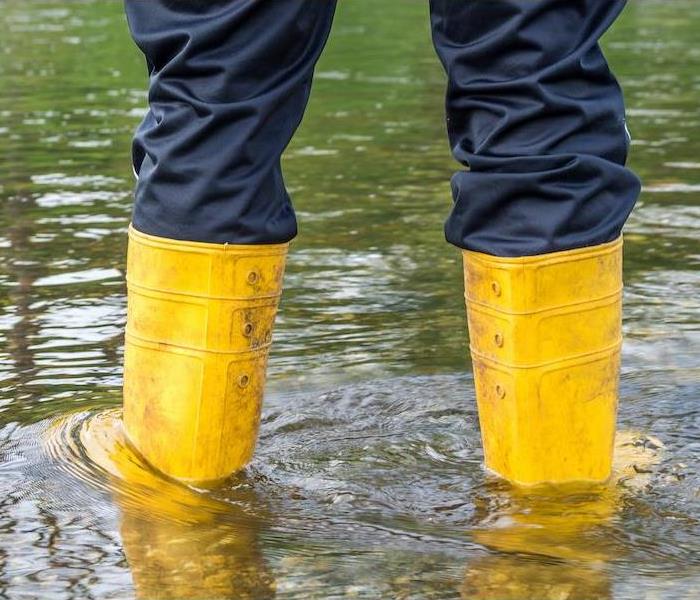Will Calling in Skilled Technicians Shorten Flood water Cleanup Times?
10/2/2020 (Permalink)
SERVPRO Uses Proven Flood Damage Restoration Methods to Handle Queens Cleanup Faster Than DIY Efforts Alone.
Street flooding from heavy rains may wreak havoc at your Queens property. Instead of breaking out the shop vac thinking that you can handle it on your own, calling in the help of skilled water restoration technicians (WRT) is the best way to get the results you need. Flood aftermath can leave lasting damage within your home if it does not get addressed carefully. SERVPRO is here to offer you the support, guidance, and manpower necessary to navigate the cleanup and restoration process. We are Faster to Any Size Disaster, meaning that we can get there quickly to start before secondary damage can set in.
What Can Happen to My Interior with All the Floodwater?
Cleaning up flood damage in Queens, calls for expertise and precision. The longer that any floodwater lingers, the more damage it creates. In addition to the devastation to building materials and contents, you also have to worry about microbial growth that brings on mold and mildew. The potential health effects from the onset of mold call for proper cleaning and sanitization throughout your interior.
Hiring skilled cleanup technicians for your residence is crucial for several reasons, such as:
- Flooding coming in from outside harbors silt, debris, chemicals, sewage, and other substances.
- As mentioned, mold growth becomes an issue that can happen rapidly within 24 hours of standing water within your home.
- Decay starts to set in, attacking wood and other materials saturated with water.
- Salt crystals from the water may also begin to leave deposits on a variety of surfaces.
- Drywall and other porous materials take on water, which causes them to swell and crumble.
- Paneling and various kinds of flooring can begin to shrink, swell, warp, and delaminate.
Is Flood water Considered Hazardous?
Flooding, especially flash floods, forces a copious amount of water into your home in a short period. This water must get handled carefully, which includes unique treatments before extraction can begin. Our team at SERVPRO will come in to assess the water levels, test the water, and make sure that the appropriate treatments get applied. All of our crew also wear personal protective equipment (PPE) throughout the project. This not only protects our crew, but it also helps ensure that we limit the amount of contamination tracked from the flood zone to unaffected areas of your interior.
How Does Flood water Extraction Work?
When you have detailed water extraction after a flood incident, it helps to shorten drying times. Our SERVPRO technicians come into your Queens property for a full assessment of the affected areas, which allows our team to determine the best way to proceed. After the loss zone is defined, our crew begins extraction to remove standing water before addressing any areas that may have hidden moisture.
- For areas with carpet and carpet padding, restoration to the preloss condition when saturated with contaminated flood water is impossible. Our techs will carefully extract water, then remove all saturated carpeting and padding below to properly dispose of it.
- After standing water and remaining moisture gets removed, and extraction wands make dry passes, our team moves into the next phase of drying.
What Happens with The Drying Phase?
Drying your interior and restoring the relative humidity within your home to the appropriate level is critical. Too much moisture left behind creates the ultimate atmosphere for mold and mildew growth. Our team opens up the loss area so that we can force air under flooring or behind wall cavities, ensuring that no place is left unaddressed. Should we discover mold colonies during the mitigation process, we can inhibit mold growth in its tracks with proper drying and sanitization methods.
Will My House Get Torn Apart?
Whenever there are materials damaged beyond repair and restoration, we perform what is known as controlled demolition. While we always work to restore rather than replace, some areas damaged call for new material installation. Some of the steps we take may include:
- Pack-outs so those belongings can be assessed, cleaned, and fully restored away from the flood-loss zone.
- Floor covering removal so that our team can thoroughly dry the subflooring below.
- Delaminated tiles may be collected and cleaned for reuse, if possible.
- Flood cuts in the drywall a few inches above the water line allow us to remove unsalvageable materials for full replacement and refinishing.
How Does Flood Damage Restoration Wrap Up?
Once we restore your interior and relative humidity is back to normal, we then do a full walk-through. SERVPRO always completes detailed inventory and reporting so that you have everything you need to facilitate your homeowner’s insurance claim. It is important to us that your interior is “Like it never even happened,” so that you can go back to your routine without any reminders of the flooding incident.
Call (718) 440-6994 to have SERVPRO of Long Island City send our Green Fleet to your property to get started on a flood damage assessment. We can be reached 24/7 for emergency cleanup services.






 24/7 Emergency Service
24/7 Emergency Service
